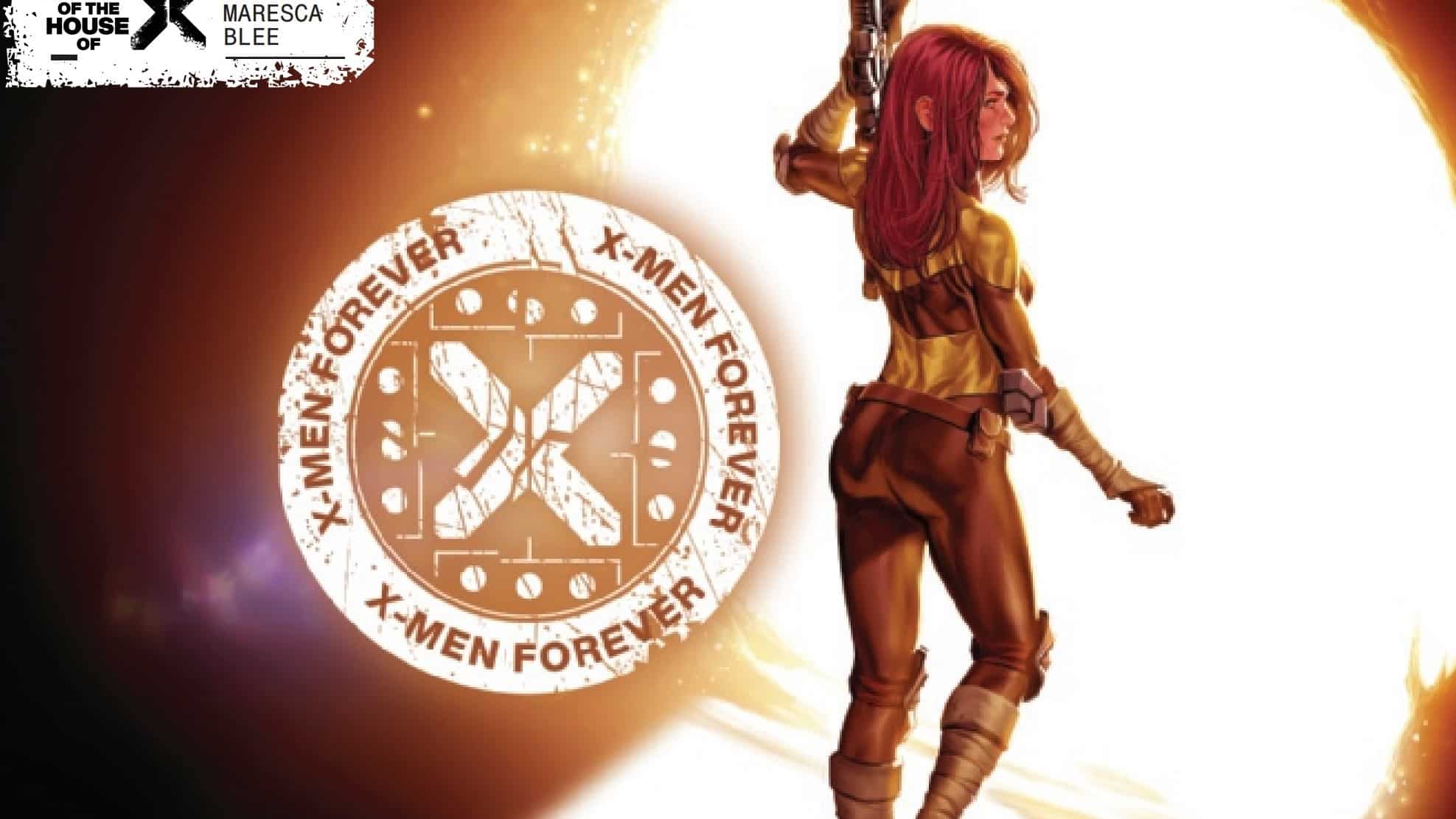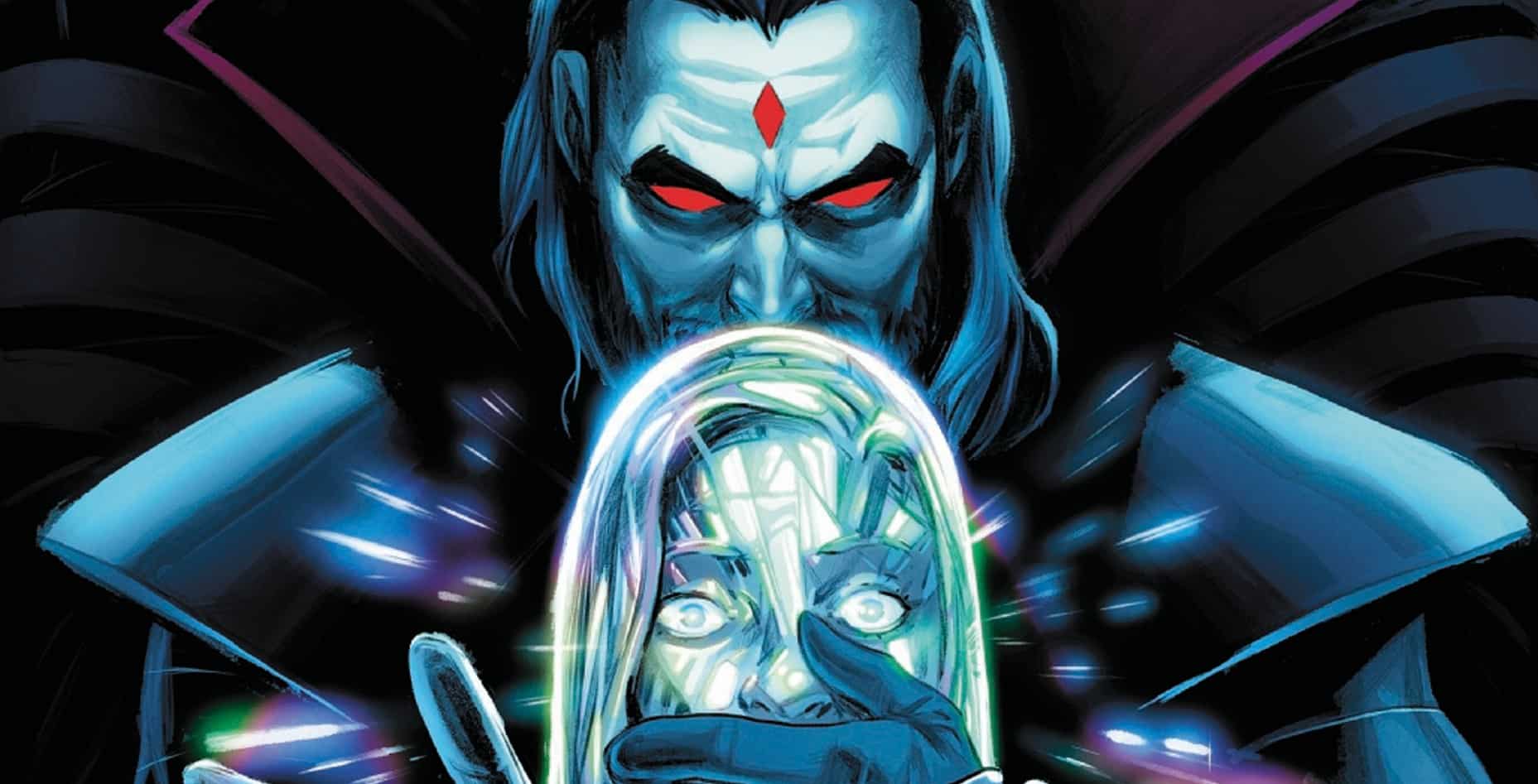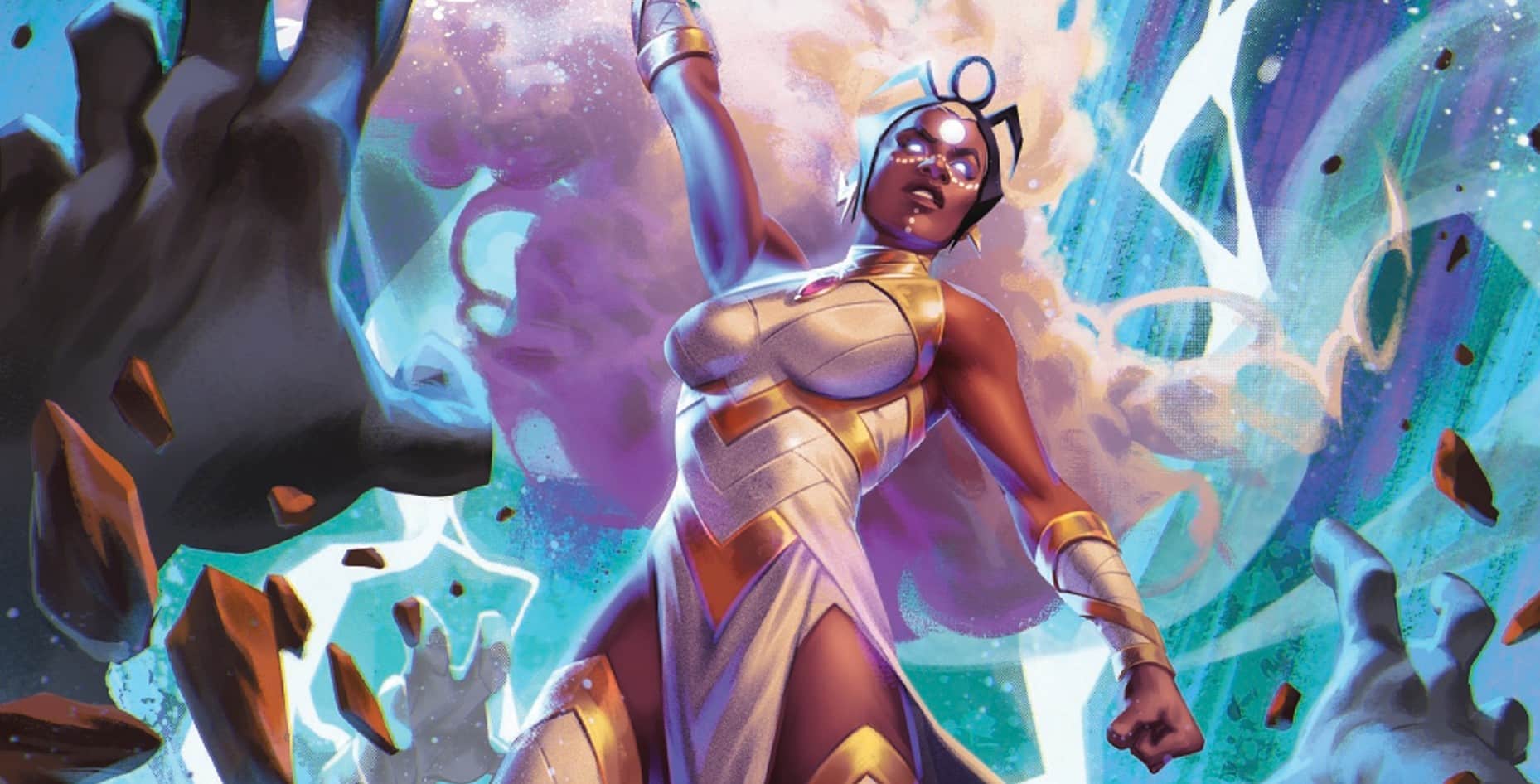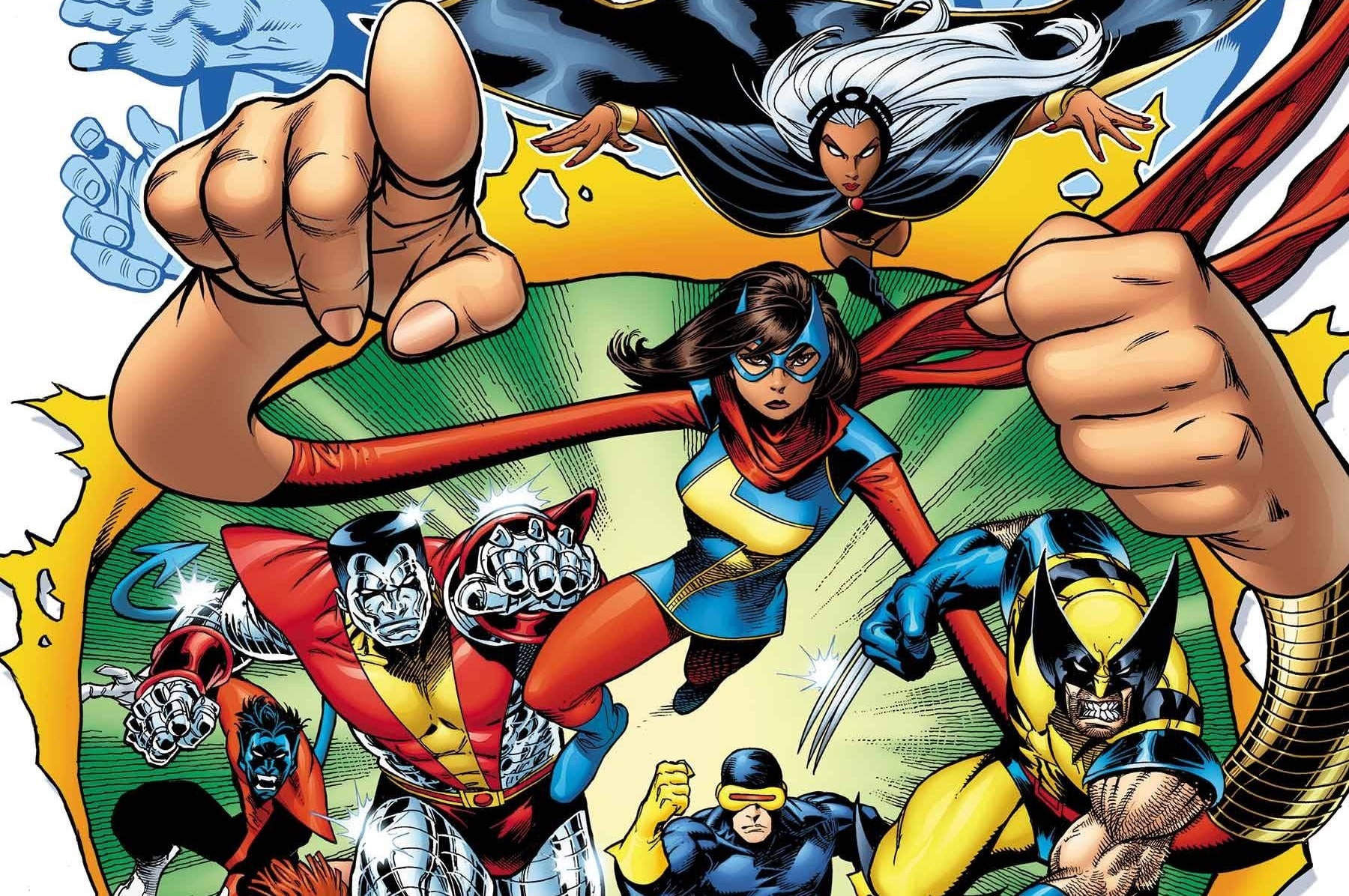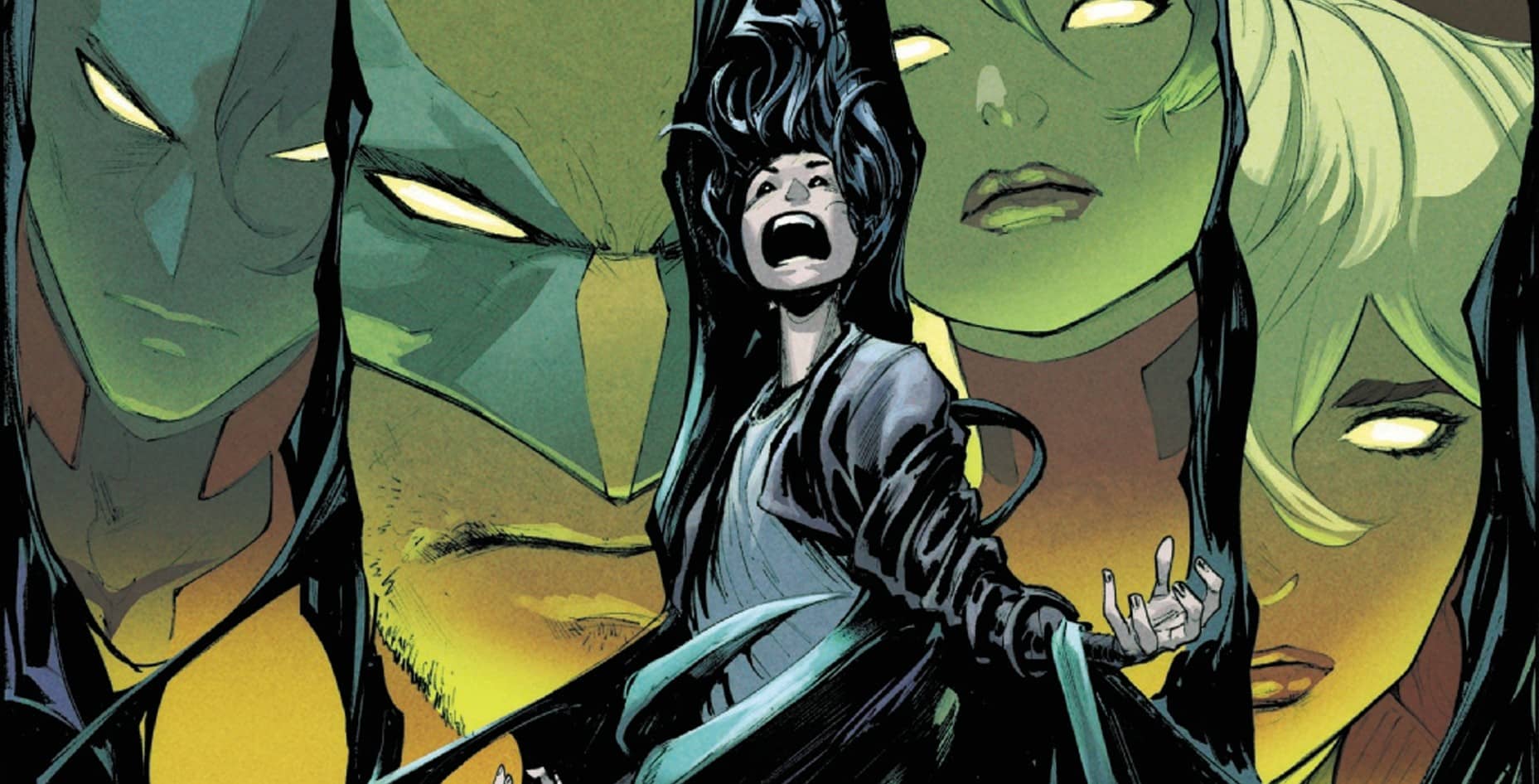Kieron Gillen’s Immortal X-Men saga comes to an end a second time, with plot threads left to other series to resolve for a second time, as Destiny and Mystique launch a rescue mission while Hope and Jean Grey act as two different kinds of midwives in X-Men Forever #4, written by Gillen, drawn by Luca Maresca, colored by Federico Blee and lettered by Clayton Cowles.
Austin Gorton: Welcome to the end of X-Men Forever, as we draw ever closer to the end of the Krakoan era of X-Men! And welcome back as well my Immortal X-Men collaborator, Mark Turetsky, and X-Men Forever co-reviewer, Tony Thornley!
Mark Turetsky: What begins must have an end, except things that are Eternal. Those end after 12 issues and an event tie-in mini. But all things Immortal never die. Those get an extra six before the event tie-in.
Tony Thornley: Here we are! The (almost) end of an era! (Note: There’s five issues left of Krakoa stuff. Unless you count the Wedding Special.)
The Taxonomy of Swears

Austin: While the previous issue bounced from character to character as it handed off the narrative, X-Men Forever #4 can be split pretty evenly between the affairs of the family Darkholme and “Hope stuff.” The cold open, if you will, of the issue is a discussion between Destiny and Sinister, in which Sinister, of all people, not only tries to give Destiny a pep talk about their efforts to stop Enigma, but actually helps improve her relationship with Mystique. I know he’s not everyone’s cup of tea, but I’m going to miss Gillen’s Sinister.
Tony: You know, rereading for this piece on the same day the X-Men ‘97 finale came out just reinforces one thing — Gillen’s Nathaniel Essex is the superior Mister Sinister. Yes, he’s a campy and flamboyant jackass, but at least he has a personality. He’s charming, he’s likable, but he’s also still unapologetically a monster.
Mark: In the sandbox tidying that’s going into this entire arc of comicbooking, he flat-out tells Destiny that in the best-case scenario, they’re “back to being hated by the chumps.” He’s not talking about the humans hating and fearing mutantkind; the “chumps” in this case are the X-Men. The good guys. He’s preparing to go back to being the villain that the next story demands he be. And he thinks he’s bringing Mystique and Destiny back with him to the villain side. But is that even possible at this point? Mystique and Destiny have been such an iconic, nigh-heroic fixture throughout the last five years that it’s almost impossible to think they might be immediately relegated to being the baddies. I think like Magneto before them, any story that tries to revert them to the red side of the ledger will have to do a lot of work. Sinister, though, he’s always been a shit. No hard work needed.
Austin: That line from Sinister about the best-case scenario sure seems like Gillen hanging a lampshade on the tenor of the upcoming “From the Ashes” relaunch, but I can’t decide if he’s trying to sell it as best he can, or indict it by having Sinister be the one to say it.
Tony: And that’s a good point about Raven and Irene. I mean, Raven has been at least an anti-hero since the Grant Morrison era, but the Krakoa era has definitely firmed her up as a protagonist. Irene’s glow-up in the era has brought her along with.
I truly hope we don’t see Sinister for at least a year-plus after next month, but if we do see him sooner, I hope it’s this version and not a regression to the dull, monologuing living mystery box.
Mark: And he gets to swear without being grawlixed! He refers to Apocalypse as a “big blue arsehole!” I can’t think of any other time that word has been written in the clear in a (non-Max, non-Adults Only) Marvel comic. My only thought is that the British spelling of the term got it past the censors. It’s classed the term up, like so:

(Also, make sure you don’t confuse it with this:)
Austin: Another thing I never expected to enjoy in the first three pages of an X-Men comic: a discussion of statistical bias, as Sinister points out that, relative to his experience with alternate timelines thanks to his Moira Engine, Destiny tends to skew her foresight into timelines where the worst things happen to Mystique because of her feelings for her. This leads Destiny to table her objections and join Mystique on the mission to rescue Xavier and get him to restore Destiny’s emotional memories of mothering Nightcrawler.
Tony: Holy cow, did I enjoy that. I mean, statistical bias is a really interesting topic, but applying it to superhero stories is the biggest roll of the die I’ve ever seen. Naturally, since it’s Gillen, he nails it and gives Destiny a unique spin on her powers at the same time. Unconscious bias is a real thing, and applying it to a sapphic pre-cog whose true love is constantly putting herself in mortal danger makes sense.
Of course Destiny’s mind is going to explore the most dangerous paths for Mystique, and naturally she’s going to see the ones that are most likely to end in her death. It’s not just good character writing, but it also opens up an interesting path for Destiny’s powers as well. Now she’s not just seeing and experiencing everything, she could potentially be more proactive while she’s at it.
Mark: I’ve been thinking lately about Destiny and Mystique’s relationship, and how it plays with the concept of capital T Tragedy (probably due to Charlie Jane Anders’ excellent interview with Kristine Johanson about the 18th century penchant for rewriting Shakespeare). In tragedy, especially in the classical sense that Aristotle writes about in his Poetics, the tragic character is tragic because of hamartia, a tragic flaw that predestines them to a tragic end (In Macbeth’s case, it’s his ambition; in Oedipus’ case, it’s hubris, etc.). We get this element of the predestined tragic end, more or less embodied by Irene (and, let’s not forget, it’s comics; Kieron Gillen bathed liberally in the idea of the destinies of comics characters at the end of storylines in Journey into Mystery). But the ability to see the future isn’t necessarily the ability to change the future (Just look at, say, Cassandra for a classical counterpart).
In this issue, we get the possibility of a hamartia for Destiny: Destiny and Mystique’s relationship isn’t destined for a bad end because they love each other too much and would burn down the world to defend the other, it’s this statistical bias that Sinister points out, that “love is a weakness.” And, like in Shakespeare’s Romeo and Juliet, even in the tragedy, there are elements of comedy. And in the comedy column, there’s their foundling child who’s been raised by others, there’s the element of disguise (Hello, Mystique!) and amnesia. Heck, we’re getting a wedding at the end of the month!
Austin: Questions: Will Alpha Flight’s Puck be in attendance, and is there a mutant who transforms into a donkey?
I’ve harped on Luca Maresca’s art a bit throughout this series, but I think his work here is stronger than in the previous issue. There’s also a good example in these opening pages of the art being hamstrung by the sheer amount of plot and character beats Gillen is having to cram in to wrap everything up. When Sinister is trying to convince Destiny the fight with Enigma isn’t hopeless, Sinister does the bit where he starts to say something sincere, then can’t finish it with a straight face and offers up a much more accurate and selfish rationale. Classic bit, very Gillen Sinister.
But the art simply doesn’t have the space to support the gag. We’re looking over Sinister’s shoulder at Destiny as he delivers the lines, all of which comes out in one speech bubble. If Maresca had the room to break the dialogue up across some panels focused on Sinister’s expression as he tries to lie and then gives up, it would have been much funnier. But there’s simply too much else to do that is more important to do than helping the pacing of the dialogue in one scene.
Tony: And while I agree, the pacing of the joke is off, Maresca is still a developing artist. I think he’s good and getting better (I still occasionally have the Nightcrawler stealing Mystique’s guns sequence from last issue pop into my head). I don’t know that he’s got the skill to pull off a gag that few artists can successfully, though.
Austin: And, to be clear, I’m laying this more at the feet of the overall pacing of the storyline across the line than at Maresca’s. There’s simply not enough room to devote multiple panels to sell a gag like that.
Mark: It’s a page containing a helluva lotta text. How do we know Gillen wasn’t trying to squeeze in one more gag after the art had already been delivered?
Austin: Conversely, the decision to portray most of Mystique and Destiny’s rescue mission off-panel, just showing them bursting into Xavier’s cell, is a smart way to use the available page count for things more important than gratuitous action. How Mystique and Destiny fought their way to that point isn’t as important as what happens after they get there.
Tony: It was a little funny how quickly they popped in, said “restore my memories” then popped back out, leaving Xavier there. Frankly, Chuck deserved the abandonment.
Mark: Oh, we’re dealing with Destiny and Professor X. Leaving him behind is just according to keikaku, mark my words.
A Whole Lotta Nickels

Tony: If I had a nickel for every time a major X-character was retconned into having two female-presenting parents in the past six months, I’d have two nickels, which isn’t a lot, but it’s weird that it happened twice.
Mark: I’ll one-up you: In the grand scheme of the start and end of the Krakoan era, two of the most pivotal moments in the creation of the entire X-mythos turn on a woman learning what it feels like to be burned to death by flamethrowers.
Austin: So here’s a question: It’s been remarked upon that Maresca’s Hope looks an awful lot like Jean throughout this series. Do you think that’s just a case of there being limitations on how distinctive an artist can draw a character when you take things like individual costumes and hair color out of the mix, or do you think it was a deliberate attempt to setup this reveal, in much the same way Gillen suddenly had Hope talking about her parents (and specifically, not knowing who her birth father is) throughout the series, to prime us for this?
Mark: There are no coincidences in art, only happy accidents that you can claim were intentional from the start.
Austin: Also, it’s worth noting here, just days before the 25th anniversary of the release of Star Wars Episode I: The Phantom Menace, that this means Hope officially pulled an Anakin, being born of a human mother and a space force.
Tony: And it’s also a confirmation of what a lot of fans have assumed. Even if the popular assumption wasn’t that she wasn’t the daughter of the Phoenix, I think most of us knew on some level the Phoenix was involved somehow.
Also, now Thor has another sister!
Austin: In all seriousness, this is a really big development for Hope. This is the payoff not only to Exodus’ faith in her but to her whole “mutant messiah” thing, the connection to the Phoenix Force in “Avengers vs. X-Men.” Phoenix is Hope, Hope is Phoenix. She’s Mutant Jesus. It’s a satisfying wrap-up not only to her role in the Krakoan era, but her entire history as a character. And by bringing us back to, essentially, the moment of her conception, Gillen underscores all of that structurally, giving us both her birth and death in the same issue, at basically the same time.
Mark: Like Exodus says, Hope is “the word made flesh.” It’s the concept of Logos (another Greek term has entered the chat). In (some) Christian theology, Logos is one of Jesus’ titles, and also the concept of his pre-existence before he became embodied. As John 1:1 puts it, “In the beginning was the Word, and the Word was with God, and the Word was God.” And to put it into the (Revised, Ewing) Marvel cosmology, she’s emerging from Tiferet, the beauty and glory of the White Hot Room. I don’t know how the concept of Tiferet and Logos interact in Christian cosmology (or if they do at all!), but to learn more about these concepts in the Marvel universe, see mine and Karen Charm’s review of Defenders: Beyond #3, true believers!
In the postmodernist, metatextual sense, Hope’s the infinite potential of the blank page, the spring from which mutantkind can grow and prosper. Gillen talked about “Judgment Day” being his most Catholic-influenced story, which I’d say this? This right here? It appends a hefty “so far!” to the end of that assertion. [pulls off sweater]
Austin: Please let the record show that Mark is wearing an “Exodus was right” shirt under his sweater.
It’s somewhat trite, but I really love the moment when Enigma makes his big pitch to Hope’s mom and she turns him down. “Everyone is a monster,” he says. In his (long) experience, “the road to genocide is short” and “we all draw a circle around what matters and kill everything that threatens it.” So “all you can do is look after yourself.” Like, it’s difficult to refute that, but comics exist in a heightened reality. So Hope’s mom still ultimately refuses him (even after he makes her experience her own death). Like, that’s just great comic bookery right there.
Mark: It’s hard not to read current events into Enigma’s summation of Krakoa. But the thing to keep in mind is that he is, himself, a genocidal monster. On the other hand, he’s an omniscient techno-god. But still, take this summary of the Krakoan age with a grain of skepticism.
Austin: And then we get reminded that Hope’s mom is a firefighter? It’s so on the nose it’s awesome.
Mark: And we get Jean Grey playing the role of the Archangel Gabriel in this Annunciation. Somehow, I feel like Jean was more gentle and kind than Enigma would have been (He’s a techno-god, but one based on the mind of a Victorian imperialist). Anyone else vaguely disturbed by the giant sign that says “COCKTAILS” right after Hope’s mom becomes pregnant? No? Just me?
The Real Krakoa Is The Friends We Made Along the Way

Austin: When Tony and I reviewed issue #2, our takeaway of the scene between Exodus and Kafka was that it essentially punted the “miscellaneous” population of Krakoa left in the White Hot Room into narrative limbo, a way to get all those mostly nameless mutants off the board more pleasantly than just massacring them all (again). I honestly didn’t expect we’d hear much from them again in the immediate future. Yet here they are, closing out the issue as Kafka attempts to bring some order to the chaos left in the wake of all the cool mutants hightailing it back to Earth. How are we feeling about this now? Was this just a way to put a more pleasant punctuation mark on their situation (“They are Krakoa, and Krakoa is immortal! See? It’s not so bad!”) or a suggestion that maybe that part of the story isn’t as over as it seemed?
Tony: I kind of felt like it was a moment of hope in a bleak situation. The thing I realized though, I don’t think that’s how the White Hot Room works. I thought it’s a timeless space, so it’s very easy for Jean and Quentin and Rachel and other Phoenices to potentially rescue them? I’m not sure.
I think the thing that surprised me was seeing Egg, Tempus, Elixir and Proteus explicitly there. It’s almost rubbing salt in the wound. All four are fascinating characters outside of being The Five, and removing them from the board limits storytelling so much. Hope is gone, and I assume so is Sinister’s DNA stash and/or Cerebro backups. The resurrection protocols are already thoroughly dismantled if they wanted them off the table, so why do they need to be there?
It feels too much like breaking the new toys while putting the old ones back in the box.
Mark: I keep thinking, the storyline isn’t done yet; we still have the rest of Rise of the Powers of X and Uncanny X-Men #700 coming up to possibly resolve this. But I’m likely kidding myself. Keeping the Krakoans in this kind of limbo, awaiting some final Judgment Day, feels appropriately Catholic (again!). What bothers me most about it is that, well, Krakoa wasn’t just the warriors who we saw fighting every month, it was its people. We don’t want Spider-Man to save New York because Iron Man, Daredevil and She-Hulk live there; we want him to save it because it’s also full of people who aren’t superheroes.
From the start of this era, Krakoa was (briefly, fleetingly, between superhero hijinks) shown as a vibrant culture full of people just living their lives. Krakoa, mutantdom, wasn’t just people who are good at fighting (though there are notable characters in-comic who would insist that the only useful mutations are martial ones, namely Apocalypse). The idea that the vast majority of mutants are just shunted off, and that the only ones who get to live in the temporal universe are the ones in jumpsuits who kiss and fight the best, that really doesn’t sit well with me.
Austin: We also get a brief hint at Exodus’ post-Krakoa setup as he says he’ll be waiting for Hope’s “second coming” (a loaded term even just in X-Men context). If we didn’t know what we know about “From the Ashes” and the obvious desire to put all things Krakoa far in the rear view as fast as possible (and/or that Gillen is done with work-for-hire comics for the time being), that line from Exodus plus this business back in the White Hot Room would make me think it was all setup for a new (probably mini) series, and that possibly the fate of Kafka and the rest of the “exiles” would be addressed there. But that seems deeply, deeply unlikely at this point. Maybe Gillen is just trying to put these toys back in the box in a way that makes it easier for someone else to take them out, however far in the future.
Mark: While I definitely have issues with this state of affairs continuing, I do really appreciate the final moments of this series. We end it in the space that’s so familiar to the Krakoan age of X-Men comics: We’re in a room with a bunch of people arguing around a circle. But unlike the previous series, Immortal X-Men, it’s not about the unelected people in the scene vying for power, stabbing each other in the back and ruling over their nation without any accountability, it’s basically a bunch of powerless people wondering “who will lead us?” And it’s Kafka, one of the most nothing of mutants created in this era, who steps up. He tells them “we have no rulers. No leaders. We’re in charge.” He steps up not because he wants power, but because someone needs to fill the role. Will it be a better government than the rotten one at the center of Krakoa? Almost certainly. Will it remain so? We’ll likely never know.
Tony: Regardless, it ends with hope, and that’s just about the most X-Men thing it could possibly be. It’s an incredibly bittersweet ending, and leaves the moments before the final battle with a quiet moment, a deep breath. For me, that’s exactly what it needed. The personal stakes among a massive battle, the greatest superhero soap opera right there.
X-Traneous Thoughts
- Doesn’t Destiny and Sinister sitting around talking about the plan to take down Enigma mean Enigma is going to know about it? I guess that ship has sailed at this point, since he’s back in time trying to knock up Hope’s mom.
- The time Phoenix burned Sinister’s city to the ground is, presumably, a reference to Uncanny X-Men (Vol. 2) #17, when the Phoenix Five destroyed Sinister London.
- Sinister telling Destiny that love is a weakness and he knows “a big blue arsehole” that could help her with that is a reference to The Further Adventures of Cyclops and Phoenix and the deal Nathanial Essex struck with Apocalypse that eventually led to the creation of Sinister.
- And also a reference to X of Swords. This issue is like an onion!
- Of all the bits of dialogue shouted by the Krakoan Leftovers at the end, favorites include, “Who’s in charge, I want to complain?” (aka the internet’s unofficial motto) and “Is there a 5G mutant?”
Buy X-Men Forever #4 here. (Disclaimer: As an Amazon Associate, ComicsXF may earn from qualifying purchases.)

